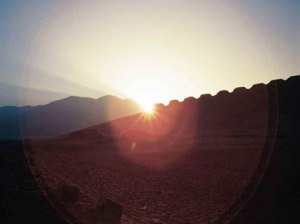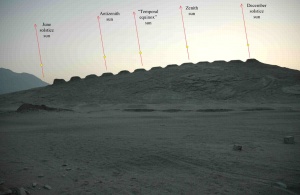
Credit: Ivan Ghezzi
Observations of the number of days between the rising and setting of the sun from tower to tower allowed ancient astronomers to create a solar calendar

Ancient space astronomy –
2,300 years ago (fourth century B.C.) ancient Peruvian astronomers living along the coast near the Casma-Sechin Oasis built a solar observatory used to mark the rising and setting of the sun. Called the Chankillo archaeological site, it consists of 13 towers spanning 980 feet (300 meters) north to south along a low rising horizon, which form an ancient observatory archaeoastronomers believe was used to track the rising and falling Sun. By timing the days it took the sun to travel between towers, the solar year could be broken into periods, scientists believe, forming a sort of solar calendar used for ceremonial and cultural purposes.
Archaeologists believe ceremonies and cultural events were held in buildings close to this ancient solar observatory. They found pottery, shells and stone carvings at the end of the 131-ft corridor in the building west of the towers, possibly left by commoners participating in solar observing ceremonies and cultural events. They also found a pair of inset staircases leading upward to each tower summit, suggesting the area was well traveled.
“Chankillo is arguably the oldest solar calendar that can be identified as such with confidence within the Americas,” said lead study author Ivan Ghezzi from Pontificia Universidad Catolica del Peru.
“Many indigenous American sites have been found to contain one or a few putative solar orientations,” Ghezzi said. “Chankillo, in contrast, provides a complete set of horizon markers and two unique and indisputable observation points.”
Around 230 meters (750 feet) to the west and east of the north and south running line of 13 towers astronomers discovered possible observation points. They also discovered that seen from these positions the 980-foot span of the 13 towers closely matches the position of the rising and falling Sun through the year.
“For example,” said Professor Ruggles, “If you stood at the western observing point, you would see the Sun coming up in the morning, but where it would appear along the span of towers would depend on the time of the year.”
“So, on the summer solstice, which is in December in Peru, you would see the Sun just right of the right-most tower; for the winter solstice, in June, you would see the Sun rise to the left of the left-most tower; and in-between, the Sun would move up and down the horizon.”
“This means ancient Peruvians could have regulated a calendar, he said, “by keeping track of the number of days it took for the Sun to move from tower to tower.”
Archaeoastronomers have found similar solar observing sites in South America built by the Incan empire between 1100 and 1530 A.D. This ancient observatory predates the Incas by 1700 years and it’s massive in size and sophisticated for its time. It also highlights the importance of observing the Sun in the daily lives and cultural of ancient Peruvians and is a testament to the scientific knowledge and will of ancient Peruvian builders and astronomers.
“Chankillo was built approximately 1,700 years before the Incas began their expansion,” Ghezzi said. “Now we know these practices are quite a bit older and were highly developed by Chankillo’s time.“
Some archaeologists think more work needs to be done
If archaeologists and archaeoastronomers are correct. Possibly as early as 600 BCE, ancient Peruvian astronomers used the Chankillo site to track the rising and setting of the sun through the solar year. As a calendar to determine moments to hold important ceremonial and cultural events. The oldest solar calendar discovered to this date in South America.
Read about future space telescopes
Learn about the ghostly afterglow of streaking Orionids meteorites
Read about plate tectonics on Europa
